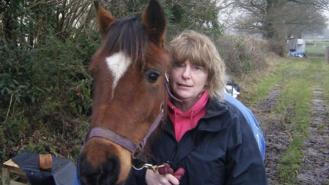
Leicester: Crime Profile
Murdertown is a true crime series that uncovers the untold stories of some of the worst crimes in modern British history. Hosted by Anita Rani, each episode chronicles a different case, with often emotional insights from local reporters, detectives, and those left bereaved.
In Leicestershire, the spotlight falls on the case of Jane Hings, a 72-year-old woman who was raped and murdered in her own home in 2017. It was an unfathomably brutal crime, and police were relieved that DNA evidence pinpointed the likely culprit. But he wasn’t about to own up to what he did, and instead offered a lurid and outlandish explanation that would defy belief.
The case that changed the world
Decades before DNA evidence proved instrumental in cracking the Jane Hings murder, this same part of England saw genetic profiling used in a police investigation for the very first time.
It was in November 1983 that the village of Narborough, just outside Leicester, was horrified by the rape and murder of 15-year-old schoolgirl Lynda Mann. Three years later, another 15-year-old girl, Dawn Ashworth, was killed in a near-identical manner.
The prospect of a serial killer in Leicestershire plunged the community into fear, and the police were desperate for clues. So there was much relief when local teenager Richard Buckland confessed to Dawn’s murder.
Although Buckland vigorously denied killing Lynda Mann, detectives were certain they’d found their man. It was only the trailblazing work of Leicester University geneticist Alec Jeffreys that prevented a terrible miscarriage of justice. Jeffreys had come up with an ingenious way to use genetic material to identify individuals – a technique that would become known as DNA fingerprinting.
Comparing semen samples left at the crime scenes with a blood taken from Buckland, Jeffreys was able to prove Buckland could not have killed either of the girls.
Detectives decided to screen the DNA of every male in the area who’d been born between 1953 and 1970. One local man was later overheard in a pub saying he’d given his DNA sample while pretending to be someone else: Colin Pitchfork, a baker who lived in the area. Pitchfork had asked his friend to impersonate him as a favour, because he – Pitchfork – had himself apparently provided a blood sample while pretending to be another friend of his who had a conviction for indecent exposure.
Following this lead, police promptly arrested Pitchfork, who pleaded guilty to both murders. The details he divulged were highly disturbing – particularly the revelation he’d killed one of the girls while his infant son was asleep in his car parked nearby.
After serving 33 years in prison, Pitchfork – now in his 60s – was deemed fit for release by the Parole Board in 2021. This decision was met by a blaze of controversy and incredulity. As South Leicestershire MP Alberto Costa put it, 'If Colin Pitchfork had committed just one of his crimes today, he would likely have received a whole life tariff which would've resulted in him probably spending the whole of his life in prison.'
In November 2021, Pitchfork was recalled to prison after approaching women on multiple occaisons.
The green bicycle mystery
In July 1919, Leicestershire became the epicentre of a murder mystery that could have been written by Arthur Conan Doyle. The victim was 21-year-old factory worker Bella Wright, who went out cycling one day, only to be found dead in a country lane near the village of Little Stretton. She had been shot in the face.
How could such a bizarrely violent crime have occurred in such sleepy, rustic surroundings? It’s a question that’s caused intrigue and debate in the century since Bella went on her fateful bicycle ride. Her destination that day had been her uncle’s cottage, and at some point during the journey she made the acquaintance of a man riding his own, distinctively green bicycle.
The man loitered around the cottage as Bella spent time with her uncle. Later, as she headed homewards, the man was seen cycling alongside her. That was the last time Bella was seen alive.
The following year, the green bicycle was discovered in a local canal. Although someone had attempted to file down the serial number, the digits were still barely legible, and they were enough for police to pinpoint who it had been sold to: a certain Ronald Light.
Although he hailed from a wealthy family and was ostensibly ‘respectable’, Light had a troubled past. He’d been expelled from school for inappropriate behaviour towards a girl, and was dismissed from an early job for daubing indecent graffiti in a toilet and setting a cupboard on fire. While serving in the Great War, he’d been court-martialled for forging military orders.
Ronald Light’s softly-spoken demeanour and well-to-do background meant he was given sympathetic press coverage when he was put on trial for Bella Wright’s murder. He cut a gentlemanly figure on the stand, admitting he had indeed cycled with Bella, but had parted company with her just before she met her end.
Despite much circumstantial evidence against Light – including his admission that he’d originally lied to police about not being the man spotted with Bella that day – he was deftly represented by his barrister, Edward Marshall Hall. Dubbed ‘the Great Defender’ for his ability to win over juries, Hall demolished the prosecution’s argument, highlighting the complete lack of hard evidence or motive (Bella had not been sexually assaulted), and suggesting that a bullet fired at close range would have resulted in a more devastating wound. Could Bella have in fact been shot accidentally at long range – perhaps by someone out hunting?
Ronald Light was sensationally acquitted, and slipped into obscurity, eventually dying in 1975 at the age of 89. Did he get away with murder? Had he, as some have suggested, killed Bella in a rage after she spurned his advances? Or had it really been some kind of bizarre accident? The latter view is bolstered by the tantalising existence of a note, apparently written by a policeman to whom Light confessed after the trial was over. The note records Light saying that Bella had been curious to see his service revolver from the war, and that the weapon had accidentally gone off as he handed it to her.
'I was horror struck, I did not know what to do,' Light allegedly told the policeman. 'I knew she was dead, I did not touch her, I was frightened and altogether unnerved and I got on my bicycle and rode away.'
Whether the note is authentic or a hoax is a riddle embedded within the larger enigma of the Green Bicycle Mystery.







